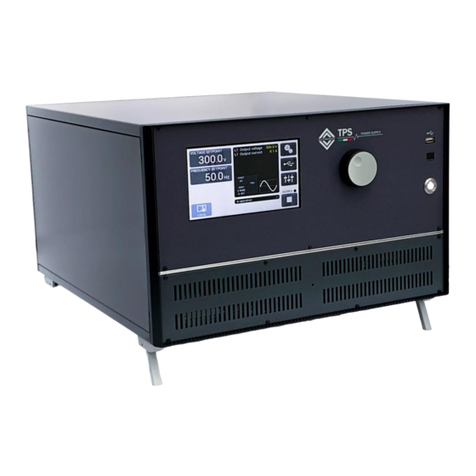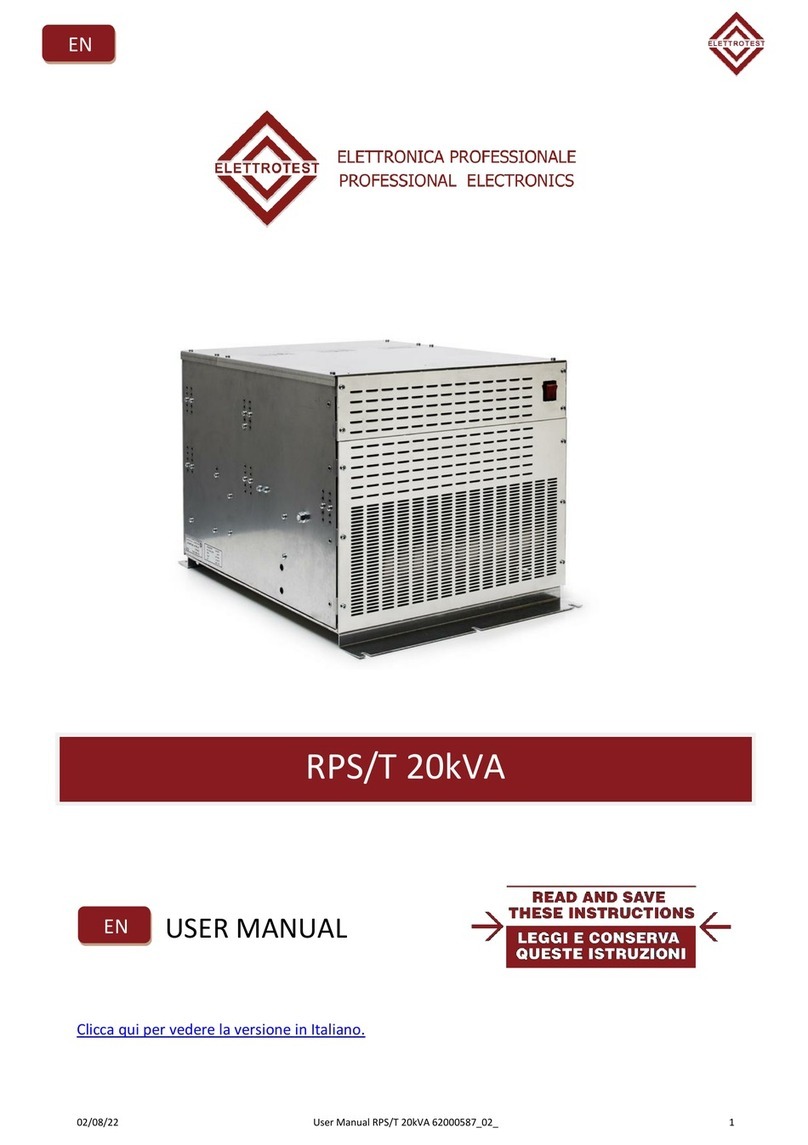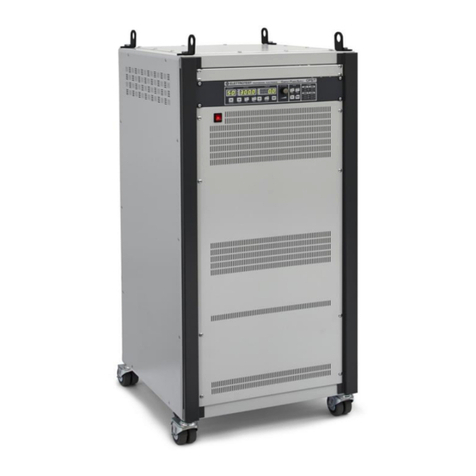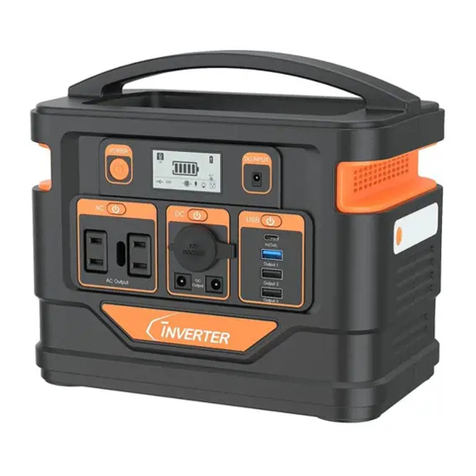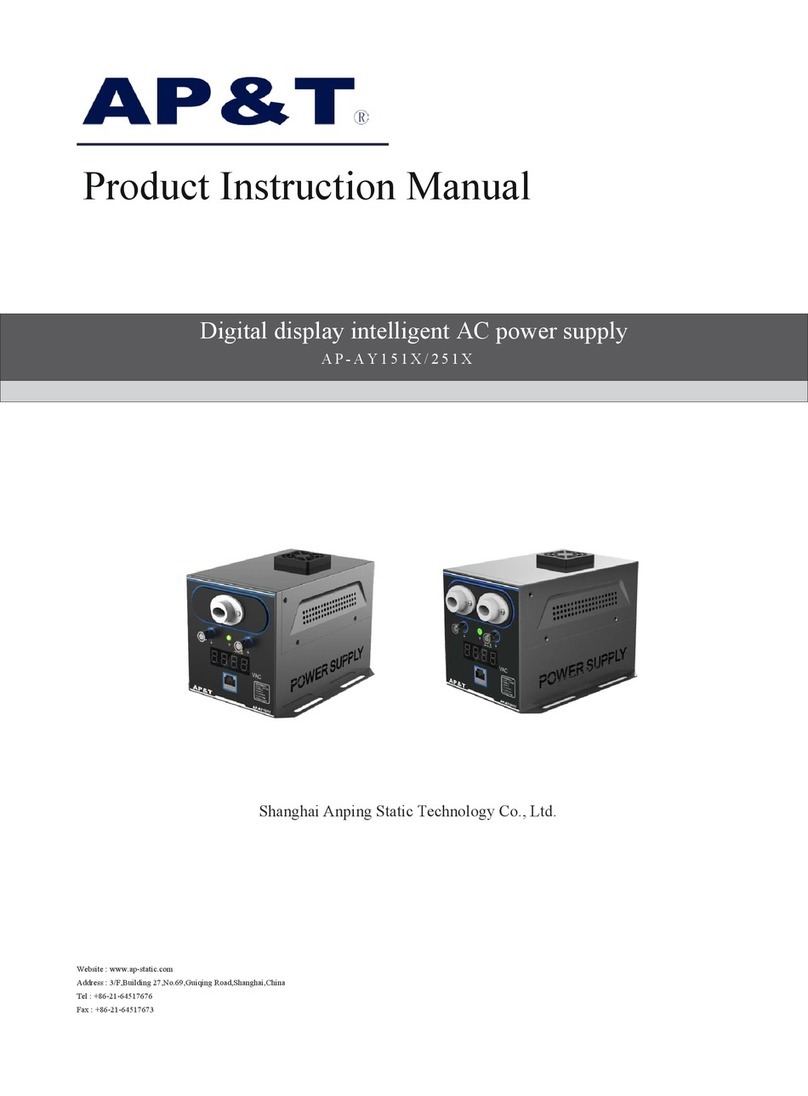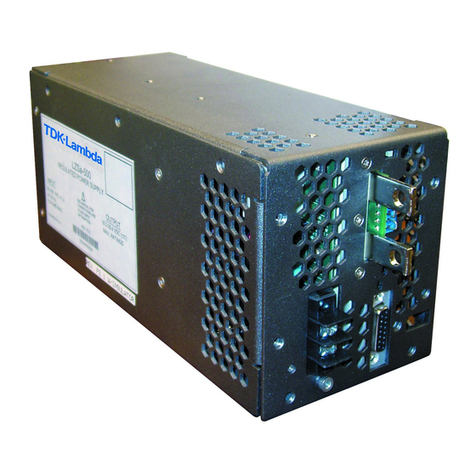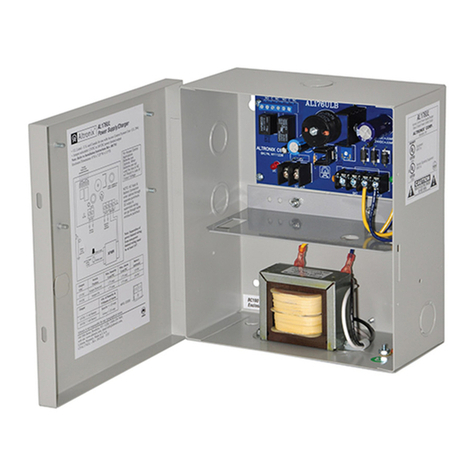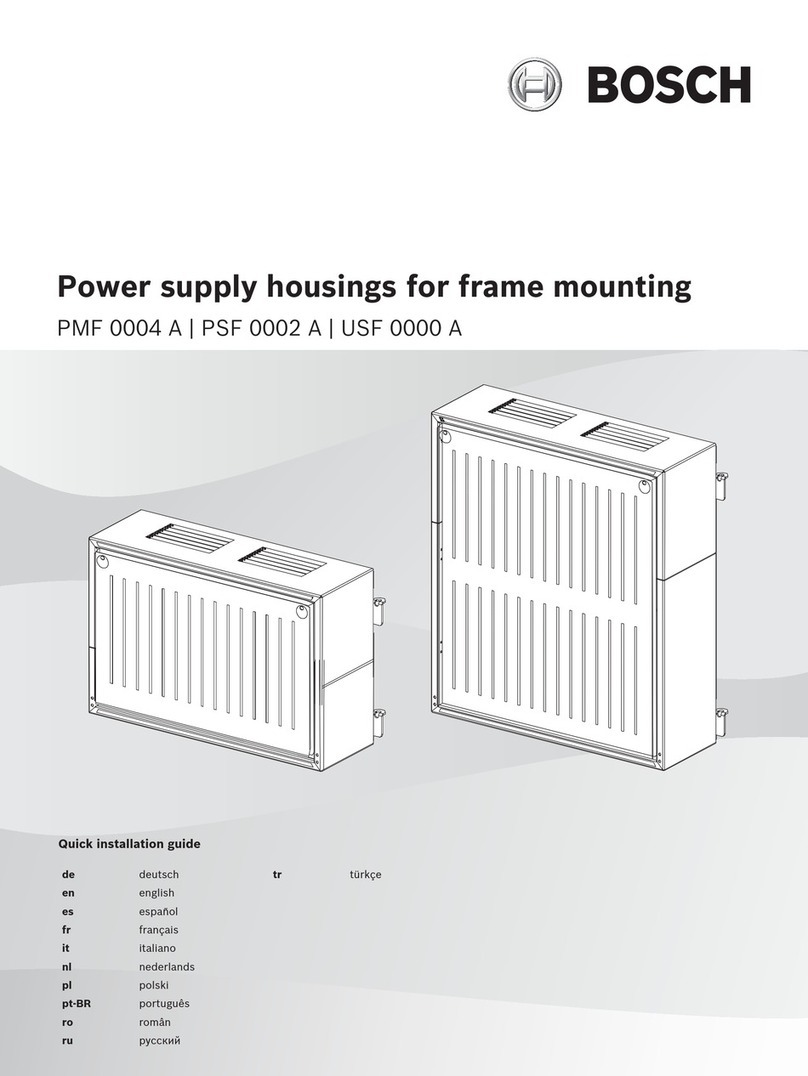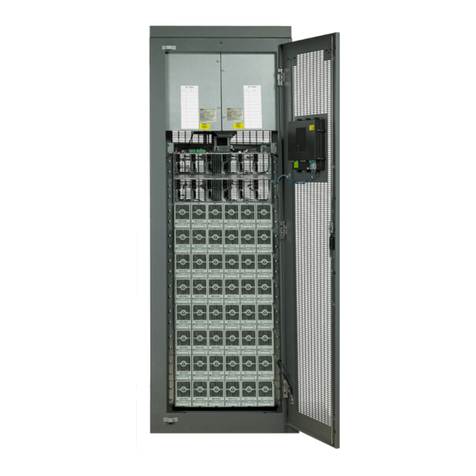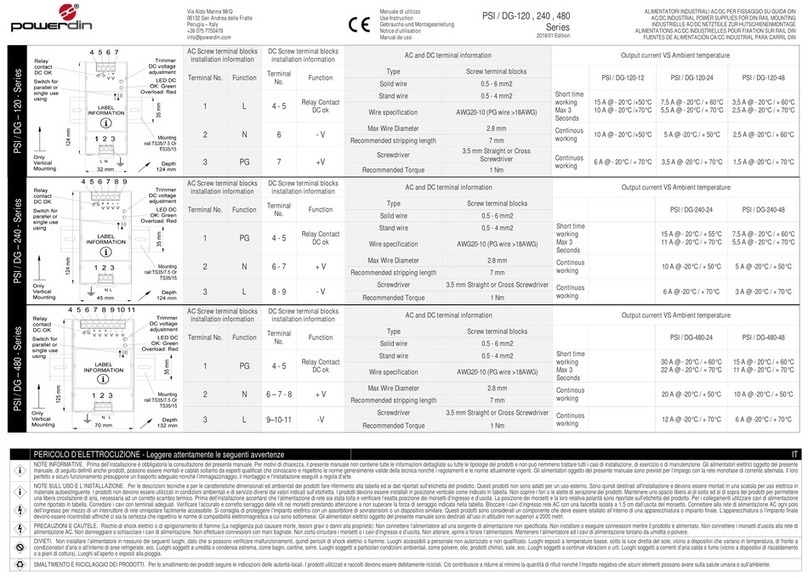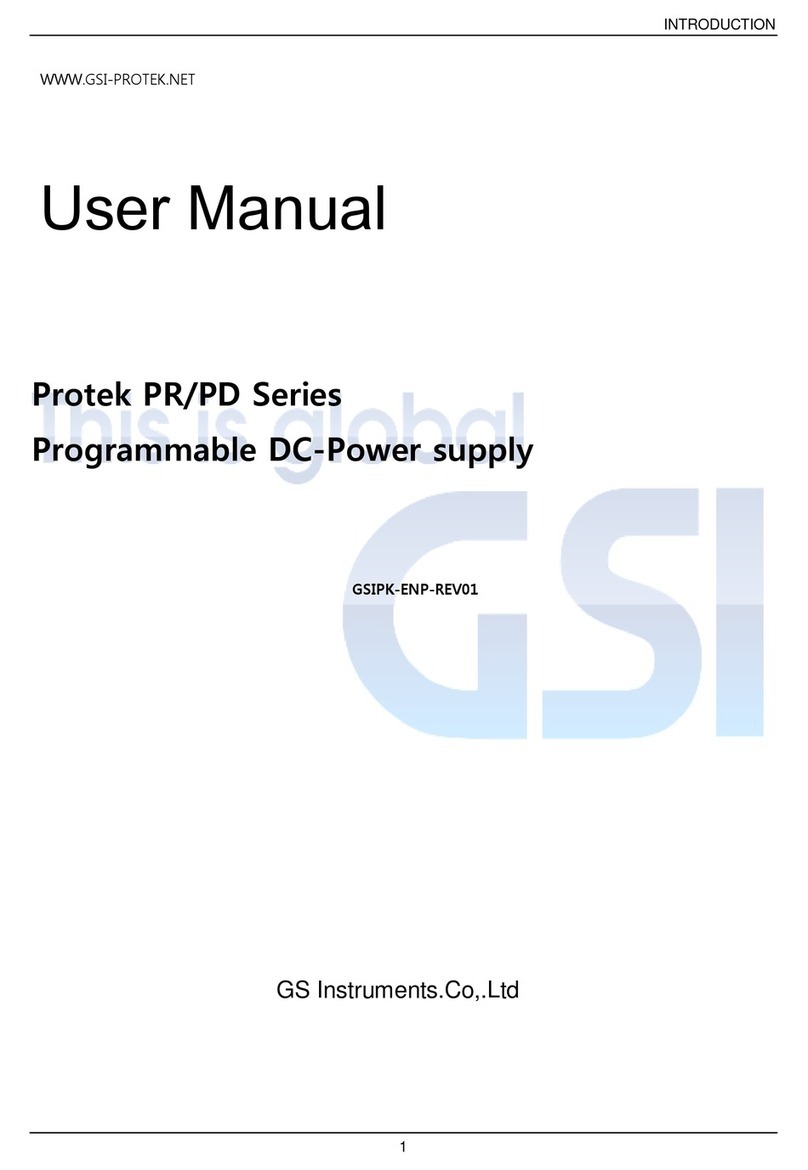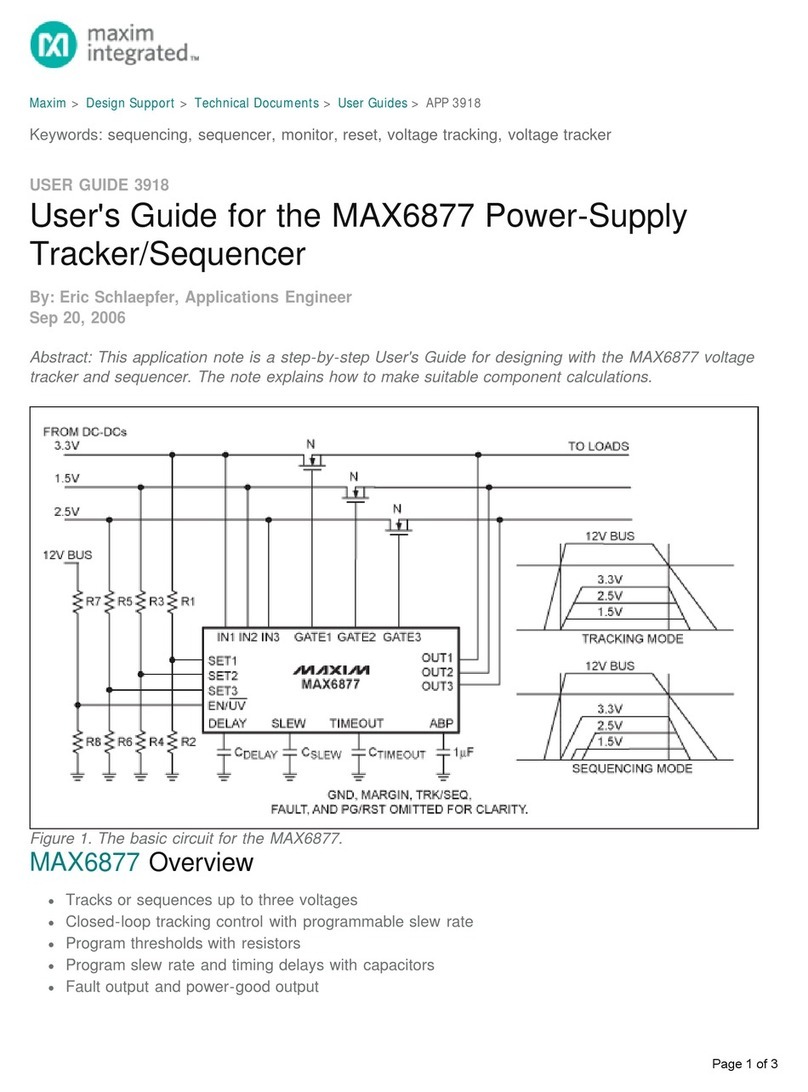Elettrotest HPS/T User manual

02/02/22 User Manual HPS/T 62000590_07_ 2
HPS/T Models covered in this manual:
Model
Code
HPS/T 60kVA
99116553
HPS/T 100kVA
99116803
HPS/T 100kVA 60k180s
99116823
HPS/T 200kVA
99116953
This manual is written from HPS/T firmware version TPSX 09_.
Please check the latest manual version at www.elettrotestspa.it
To consult older manual versions, please contact our support at

02/02/22 User Manual HPS/T 62000590_07_ 3
Document list:
This manual is completed by a list of documents, useful to understand all the features of your
HPS/T.
Scan the QR-code or click on the link to directly download the documents.
Documents
Description
Link
QR-code
User Manual
Latest manual version
Manual
Brochure
Brochure for all the TPS-HPS-CPS models
Brochure
TPS Parameters
Describes all the machine modifiable
parameters and the start-up sequence.
TPS
Parameters
TPS protocol
Elettrotest
Describes how the Elettrotest remote
communication protocol works.
Elettrotest
Protocol
TPS protocol
SCPI
Describes how the SCPI remote
communication protocol works with your
HPS/T.
SCPI
Protocol

02/02/22 User Manual HPS/T 62000590_07_ 5
Elettrotest Spa
P,zza R.Riello 20/B
45021 Badia Polesine (RO)
Italy
+39 042553567
www.elettrotestspa.it
After sale support
Thank you for purchasing the HPS/T generator.
HPS/T is a three-phase generator that provides a perfectly sinusoidal and stable voltage. The
voltage value can be adjustable either in frequency and amplitude.
HPS/T combines the advantage of the power line, the variac and the rotary converter, without
having their shortcomings.
Responsability:
Elettrotest disclaims any responsibility for damage to people or things
caused by an improper use of its products.
Mandatory
-Verify voltage, power and frequency compatibility between HPS/T range and electrical
specification of equipment under test (EUT).
-Electrical components of the system must be suitable for the rated voltage and current of HPS/T
model
-The electrical components, which by construction cannot support external influences (of the
generator in all its range), can only be used on condition that adequate additional protection has
been provided with automatic disconnection protection.
Notes:
This manual lists precautions and information about operating procedure of device.
The content of this manual is subject to change without prior notice because of continuing
improvements on the instrument’s
Should you have any questions or find any error please contact us by email.
Copying or reproducing all or any part of the contents of this document is strictly
prohibited, without Elettrotest permssion
Version:
This manual is written for HPS/T firmware version TPSX 09_ and higher.

02/02/22 User Manual HPS/T 62000590_07_ 6
SAFETY WARNINGS
The manufacturer urges users to read the user manual for our products before installation.
The installation must be carried out by qualified technical staff. The non-observance of the
warnings in this manual can cause electric shocks, even fatal ones.
Please find some general safety warnings below.
•This equipment must be connected to the mains supply using the appropriate safety
devices.
•HPS/T must be connected to safety ground through the correct connections. The non-
observance or the degradation of this earth connection can lead to electric shocks, even fatal
ones. As regards the correct connection modes, please refer to the information contained in
paragraph 4.
•Disconnect HPS/T from the mains before any work on the equipment and on the connected
power loads.
•Before touching the load or the output connector make sure that the power supply on the
device has been disconnected for at least 5 minutes. This is the time necessary in order for the
capacitors inside the device to discharge. The non-observance of this discharge time can lead to
electric shocks, even fatal ones.
•Avoid heavy shocks to the equipment (especially during transport) or exposure to extreme
weather conditions.
•Any damage to the product due to transportation, incorrect installation or improper use is
not covered by the guarantee supplied by the manufacturer.
•Do not use the equipment in explosive environments or in the presence of dust, acids or
corrosive and/or inflammable gases.
•Tampering with or dismantling any component in the equipment will void the warranty
automatically.
•Do not operate or store under conditions where condensing may occur or where
conductive debris may enter in the case.
•Keep the ventilation holes on the front and rear free from obstruction.
•Do not make dielectric strengths test on the input or output of the equipment. Contact
Elettrotest if you need to do specific test
ELECTRIC RISK
There are dangerous voltages inside HPS/T and over the output connector.
The non-observance of the warnings suggest in this manual can lead to electric
shocks, even fatal ones.
OVERHEATING RISK
In the case of a ventilation system failure, the metal parts of the inverter may reach
high temperatures (in some cases higher than 70°C).

02/02/22 User Manual HPS/T 62000590_07_ 7
DISPOSAL
INFORMATION FOR USERS ON THE CORRECT HANDLING OF WASTE
ELECTRICAL AND ELECTRONIC EQUIPMENT (WEEE)
In reference to European Union directive 2012/19/EU issued on 24 July 2012 and the related
national legislation, please note that:
•WEEE cannot be disposed of as municipal waste and such waste must be collected and
disposed of separately;
•the public or private waste collection systems defined by local legislation must be used. In
addition, the equipment can be returned to the manufacturer at the end of its working life when
buying new equipment;
•the equipment may contain hazardous substances: the improper use or incorrect disposal
of such may have negative effects on human health and on the environment;
•the symbol (crossed-out wheeled bin) shown on the product or on the packaging and on
the instruction sheet indicates that the equipment must be disposed of separately;
•in the event of illegal disposal of electrical and electronic waste, the penalties are specified
by local waste disposal legislation.

02/02/22 User Manual HPS/T 62000590_07_ 8
INDEX
1. INTRODUCTION..........................................................................................................................10
1.1. MAIN FEATURES ..................................................................................................................10
1.1.1. Output voltage .............................................................................................................10
1.1.2. Output frequency.........................................................................................................11
1.1.3. User interface...............................................................................................................11
2. MODELS......................................................................................................................................12
2.1. MECHANICAL DRAWINGS....................................................................................................13
2.1.1. HPS/T 60kVA | HPS/T 100kVA | HPS/T 100kVA 60K180S ......................................13
2.1.2. HPS/T 200kVA 120K360S .............................................................................................14
2.2. LIMIT CURRENT FOR MODELS WITH IN RUSH CAPABILITIES ..............................................15
2.3. MAXIMUM OUTPUT VOLTAGE AND FREQUENCY...............................................................15
3. NOTES FOR USERS......................................................................................................................16
3.1. SWITCHING ON....................................................................................................................16
3.2. PARAMETERS PROGRAMMING MODE................................................................................16
3.1. VOLTAGE MENU ..................................................................................................................16
3.1.1. Setting Voltage.............................................................................................................16
3.2. RANGE SETTING...................................................................................................................17
3.3. VOLTAGE VISUALIZATION....................................................................................................18
3.4. FREQUENCY MENU..............................................................................................................19
3.4.1. Frequency setting.........................................................................................................19
3.4.2. Frequency reference setting........................................................................................19
3.5. MODE MENU.......................................................................................................................20
3.5.1. Voltage reaction...........................................................................................................20
3.5.2. Output type..................................................................................................................21
3.5.3. Continuous or INRUSH mode.......................................................................................21
3.6. ALARMS ...............................................................................................................................21
3.6.1. Supply alarms...............................................................................................................22
3.6.2. System alarms..............................................................................................................22
3.6.3. Current alarm...............................................................................................................22
3.6.4. Voltage alarm...............................................................................................................22
4. INSTALLATION............................................................................................................................23
4.1. GENERAL NOTES..................................................................................................................23
4.1.1. INSPECTION..................................................................................................................23
4.1.2. Line Connection ...........................................................................................................23
4.2. PROTECTIONS......................................................................................................................23
4.2.1. RCD Protection.............................................................................................................23
4.2.2. Magneto-Thermic protections.....................................................................................24
4.2.3. Protections Wiring Diagram.........................................................................................24
4.3. WIRING DIAGRAM...............................................................................................................25
4.3.1. Single/Three phase - 2-WIRES configuration...............................................................25
4.3.2. Single/Three phase 4-WIRES configuration.................................................................26
4.4. INSTALLATION NOTE ...........................................................................................................27
4.4.1. HPS/T 60K | HPS/T 100K 60K120S ............................................................................27
4.4.2. HPS/T 200K 120K360S..................................................................................................28
5. REMOTE CONTROl......................................................................................................................29
5.1. SERIAL REMOTE CONTROL ..................................................................................................29

02/02/22 User Manual HPS/T 62000590_07_ 9
5.1.1. RS232 Serial cable ........................................................................................................29
5.2. EXISTENCE TABLE.................................................................................................................29
6. ACCESSORIES..............................................................................................................................30
6.1.1. HPS/T 60K.....................................................................................................................30
6.1.2. HPS/T 100K | HPS/T 100K 60K180S ...........................................................................30
6.1.3. HPS/T 200K 120K360S.................................................................................................30
7. Service and maintenance...........................................................................................................31
7.1. MAINTENANCE / CLEANING................................................................................................31
7.1.1. Scheduled maintenance...............................................................................................31
7.2. ALARMS DIAGNOSIS AND REPAIRS .....................................................................................31
7.3. BASIC TROUBLESHOOTING..................................................................................................32
7.3.1. Overvoltage/Undervoltage alarms ..............................................................................32
7.3.2. Overtemperature alarm...............................................................................................32
7.3.3. Inverter alarm ..............................................................................................................33
7.3.4. Max DV OUT alarm.......................................................................................................33
7.3.5. Limit IOUT alarm ..........................................................................................................33
8. GUARANTEE ...............................................................................................................................34
9. REVISION INDEX .........................................................................................................................34

02/02/22 User Manual HPS/T 62000590_07_ 10
1. INTRODUCTION
HPS/T is a power source that supplies sinusoidal stable voltage. Its output voltage is adjustable in
frequency and amplitude.
HPS/T has an isolated output thanks to a special isolating transformer at constant power. This
transformer allows to have always the maximum power in any application, keeping the complete
insulation from the electrical line.
HPS/T can also be controlled remotely.
One of the HPS/T peculiarity is the isolated output, thanks to a special isolating transformer at
constant power. This transformer allows to have always the maximum power in any application,
keeping the complete insulation from the electrical line.
1.1. MAIN FEATURES
1.1.1. Output voltage
The output voltage is guaranteed perfectly sinusoidal, with a distortion of less than 0.6 % with
resistive load.
The value of output voltage is kept perfectly stable within 0.1 % regardless of the load.
HPS/T is also able to compensate possible voltage drops on the output wires, ensuring in this way
the exact voltage you want on the load.
The load that HPS/T is able to drive can vary from the pure capacity to the pure inductance not
only, but also up to non-symmetrical current loads, as for instance a single half wave rectifier.
The output voltage is adjustable with continuity from zero to full scale of each range.
HPS/T can in fact provide the nominal power at various full scales and this allows the HPS/T to
adapt himself to the disparate needs of the user, without having heavy limitations on the output
current.
The HPS/T has only a balanced three phase output, but it’s able to supply a single-phase load, in
this case the maximum power is 1/3 respect to the nominal power
Furthermore, HPS/T is capable to keep the voltage stable also with time variable loads, as for
example the pulsating loads. In fact, HPS/T recovers the distortion of the waveform within 0.6 %
and the amplitude of the voltage within 0.1% in less than half period.
HPS/T can bear a shortcircuit for an indefinite time without suffering any consequence.

02/02/22 User Manual HPS/T 62000590_07_ 11
1.1.2. Output frequency
HPS/T allows the regulation of the output frequency from 50 to 80Hz at maximum voltage.
This output frequency can be regulated with continuity within the above-mentioned range of
frequencies and it has a stability of 0.01% with respect to the set frequency.
HPS/T also allows to synchronize the output frequency with the frequency of the supply line; this
synchronization is obtained both in frequency and phase.
This allows a completely synchronous output, with a zero-phase error regard to the supply line,
but with a completely insulated output and with a far superior voltage stability.
1.1.3. User interface
HPS/T is intended to have an user friendly interface.
It is also featured the possibility of a host computer control, thus allowing to perform tests
automatically.
HPS/T allows various usage selections: working range, wires drop compensation, working
frequency, syncronization of the output frequency with the power line.
Furthermore, HPS/T gives the user clear information on the status of the output.
It is monitored both the set voltage and the set frequency and the output voltage is read with a
precision of 0.6%.
The user is also warned in case of over current obtainable by the HPS/T, or in case of high loss in
the wires, that should not exceed 5% of the set voltage.
We underline again that HPS/T automatically limits the maximum allowed current, avoiding
damages to the equipment; the only consequence is that, in this case, it is not guaranteed the
precision of the output waveform neither the accuracy of the output voltage.
The user can set the output voltage through the numeric keyboard, or he can continuously vary
the voltage through specific keys. The same possibility is valid for the setting of the frequency.
The above possibility makes the HPS/T very flexible in those applications where it is requested a
continuous variation of the two regulated magnitudes, around a given values.

02/02/22 User Manual HPS/T 62000590_07_ 12
2. MODELS
All HPS/T models characteristics are shown in the table hereunder.
HPS/T 60KVA
HPS/T 100KVA
HPS/T 100KVA 60K180S
HPS/T 200KVA
HPS/T 200KVA PARALLEL
Code
99116553
99116803
99116823
99116953
99116963
Configuration
Continuous
Continuous
Continuous
Inrush
Continuous
Inrush
Continuous
Inrush
Power
60KVA
100KVA
100KVA
60KVA/180KVA
200KVA
120KVA/360KVA
200KVA
120KVA/360KVA
Output
3phase1)
3phase1)
3phase1)
3phase1)
3phase5)
Caratteristic
Isolated
Isolated
Isolated
Isolated
Isolated
Voltage
Range
150V/300V2)
150V/300V2)
150V/300V2)
150V/300V2)
150V/300V2)
Accuracy
<0.5%
<0.5%
<0.5%
<0.5%
<0.5%
Distorsion
<0.6%3)
<0.6%3)
<0.6%3)
<0.6%3)
<0.6%3)
Stability of the output voltage
<0.1%
<0.1%
<0.1%
<0.1%
<0.1%
Recovery time of the waveform
<10ms
<10ms
<10ms
<10ms
<10ms
Maximun Compensated drop
5% f.s
5% f.s
5% f.s
5% f.s
5% f.s
Recovery-time of drop on wires
<200ms.
<200ms.
<200ms.
<200ms.
<200ms.
Output voltage resolution
0.025% f.s.
0.025% f.s.
0.025% f.s.
0.025% f.s.
0.025% f.s.
Maximum current single phase
Configuration
Continuous
Continuous
Continuous
Inrush
Continuous
Inrush
Continuous
Inrush
Range
150V
300V
150V
300V
150V
300V
150V
300V
150V
300V
150V
300V
150V
300V
150V
300V
RMS continuous 3)
137A
68A
228A
114A
228A
114A
137A
68A
456A
228A
270A
135A
456A
228A
270A
135A
Inrush Current (3 seconds) 3)
196A
98A
No inrush
No inrush
No inrush
410A
205A
No inrush
837A
410A
No inrush
837A
410A
Maximum current three phase
Configuration
Continuous
Continuous
Continuous
Inrush
Continuous
Inrush
Continuous
Inrush
Range
150V
300V
150V
300V
150V
300V
150V
300V
150V
300V
150V
300V
150V
300V
150V
300V
RMS continuous 3)
137A
68A
228A
114A
228A
114A
137A
68A
456A
228A
270A
135A
456A
228A
270A
135A
Inrush Current (3 seconds) 3)
196A
98A
No inrush
No inrush
410A/205A
No inrush
837A/410A
No inrush
837A/410A
Frequency
Output frequency range
50Hz4) - 80Hz6)
50Hz4) - 80Hz6)
50Hz4) - 80Hz6)
50Hz4) - 80Hz6)
50Hz4) - 80Hz6)
Range of syncronization
45Hz - 65Hz
45Hz - 65Hz
45Hz - 65Hz
45Hz - 65Hz
45Hz - 65Hz
Frequency resolution
0.02Hz
0.02Hz
0.02Hz
0.02Hz
0.02Hz
Frequency precision
100ppm
100ppm
100ppm
100ppm
100ppm
Supply
Input supply
400Vac±10% 3PH
400Vac±10% 3PH
400Vac±10% 3PH
400Vac±10% 3PH
400Vac±10% 3PH
Maximum Input current
150A
250A
250A
500A
500A
Input Frequency
50Hz-60Hz
50Hz-60Hz
50Hz-60Hz
50Hz-60Hz
50Hz-60Hz
Other
Size (H : W : D)(mm)
1670 : 920 : 825
1670 : 920 : 825
1670 : 920 : 825
1800 :1200 : 1000
1800 :1600 : 1000
Weight
640 Kg
800 kg
800 kg
1400 Kg
1600 Kg
Protections
OVP,UVP;OTP
OVP,UVP;OTP
OVP,UVP;OTP
OVP,UVP;OTP
OVP,UVP;OTP
Operation Temperature Range
0-35°C
0-35°C
0-35°C
0-35°C
0-35°C
RS232
YES
YES
YES
YES
YES
RS485
OPTION
OPTION
OPTION
OPTION
OPTION
LAN
OPTION
OPTION
OPTION
OPTION
OPTION
1) It is possible to use in single phase mode but with 1/3 of nominal power. It is possible asymmetrical output current.
2) Other range on request.
3) With Resistive load.
4) It is possible on remote interface to set 10Hz but you must decrease the maximum voltage.
5) The parallel machine has a three single phase transformers so you can change the module and the phase of each line
6) You can set up 320Hz by serial command, but with derating of performance and maximum voltage

02/02/22 User Manual HPS/T 62000590_07_ 13
2.1. MECHANICAL DRAWINGS
2.1.1. HPS/T 60kVA | HPS/T 100kVA | HPS/T 100kVA 60K180S
HPS/T 60KVA - HPS/T 100KVA - HPS/T 100KVA 60K180S
1
3
3
4
2
2
3
2
2
(*) All measure are on mm
1 –General switch
2 –Fans
3 –Ventilation Grills
4 –Rear panel for connection

02/02/22 User Manual HPS/T 62000590_07_ 14
2.1.2. HPS/T 200kVA 120K360S
HPS/T 200KVA 120K360S
1200
1800
1000
1
2
2
2
2
2
2
3
3
3
4
4
3
3
3
3
3
3
3
(*) All measure are on mm
1 –General switch
2 –Fans
3 –Ventilation Grills
4 –Rear panel for connection

02/02/22 User Manual HPS/T 62000590_07_ 15
2.2. LIMIT CURRENT FOR MODELS WITH IN RUSH CAPABILITIES
2.3. MAXIMUM OUTPUT VOLTAGE AND FREQUENCY
0.00
0.50
1.00
1.50
2.00
2.50
3.00
3.50
0.0 10.0 20.0 30.0 40.0 50.0 60.0
Time (sec)
I/Io
0%
20%
40%
60%
80%
100%
120%
010 20 30 40 50 60 70 80
FREQUENCY
Vo / V nom

02/02/22 User Manual HPS/T 62000590_07_ 16
3. NOTES FOR USERS
3.1. SWITCHING ON
As soon as HPS/T switches on, through the switch placed on the control panel of the machine, it
makes different cycles of test, indicated by the progression of the numbers from 0 to 9 on the
displays.
In case of bad working the test stops and the machine indicates on the control panel the type of
alarm checked (see at the voice alarms).
When the test ends HPS/T is set to 0 Volt in the range 300 Volt, 50 Hertz and regulation on the
output terminals (2 wires).
After the appearing of these indications HPS/T is ready to work.
3.2. PARAMETERS PROGRAMMING MODE
HPS/T allows you to change various generator start parameters through the programming mode.
The programming mode allows you to configure a starting profile of the application, different from
the factory one.
The modifiable parameters and how to access the programming mode are illustrated in the
Configure parameters quick guide.
3.1. VOLTAGE MENU
3.1.1. Setting Voltage
There are two ways to set the Voltage: through the appropriate buttons UP and DOWN placed on
the left on the control panel or through the numeric keyboard.

02/02/22 User Manual HPS/T 62000590_07_ 17
The buttons UP and DOWN, respectively indicated with a little arrow upwards and downwards,
permit a continuous variation of the output voltage; the speed of the output voltage variation
depends on time the button is pushed, as time increases, the speed of the output voltage variation
progressively increases.
Instead, if you want to set a fixed output voltage, you can use the numeric keyboard situated on
the right side of the control panel.
To set a fixed output voltage proceed in the following way:
1. Push the button PROGRAM (the corresponding led switches on)
2. Push the button VOLT (the volt display switches off)
3. Digit the required voltage through the numeric keyboard (the numbers are visualized on
the display)
4. Push ENTER.
After pushing ENTER the display begins to blink, this is to indicate the output is going to the set
voltage, as soon as the connection takes place, the display stops to flash and the PROGRAM led
shuts off.
In case of error, you can push the button CLEAR which causes the exit from the programming
routine.
The maximum voltage is equal to the set off range.
Moreover, if the set off voltage is not coherent with the set off range (for example the setting of a
voltage exceeding the range) the datum is not accepted after pushing ENTER.
3.2. RANGE SETTING
The HPS/T range buttons allows to make use of the full output power at different voltages.
There are two different ranges: 300 Volt and 150 Volt.

02/02/22 User Manual HPS/T 62000590_07_ 18
The maximum output power changes according to the nature of the connected load; in case of
resistance loads the power is nominal, in case of pure inductive loads the power increases, in
case of pure capacity load the power diminishes.
To change the range, push the button corresponding to the requested range placed on the left
of the command panel under the voice RANGE VOLT.
When the range is changed, the display showing the set voltage turns off and the output voltage
goes down slowly till zero, then the output power is switched off; after about 15 seconds the
output is switched on again and the Volts display visualizes zero voltage (0.0); since that moment
HPS/T is ready to receive on the new range.
3.3. VOLTAGE VISUALIZATION
The display concerning the output voltage can visualize the set voltage or the output voltage with
four digits both.
At turn on, the display visualizes the set voltage and this is indicated by the led on the button SET
in the DISPLAY VOLT section of the panel.
In order to visualize the actual output voltage, push the corresponding button (OUT); the
visualized voltage indicates the output voltage with a precision of 0.3% at full scale range.
If the set voltage is changed, the display returns to show the set value.
In case of 4 wires operation, the display shows the voltage on the sense inputs.

02/02/22 User Manual HPS/T 62000590_07_ 19
3.4. FREQUENCY MENU
3.4.1. Frequency setting
The output frequency of HPS/T can change between 40 and 80 hertz.
To set the frequency proceed likewise the setting voltage through the buttons UP and DOWN
(upwards and downwards arrow) and by means of the programming numeric keyboard.
To set the frequency through the programming numeric keyboard you can proceed likewise the
voltage pushing the button HERTZ instead of the button VOLT thus indicating to HPS/T that you
want to program the frequency.
Either in this case after pushing the button ENTER the display concerning the Hertz value
visualization flashes until the output frequency coincides with the set one.
If you plan a frequency exceeding the frequency range, the input value is not accepted pushing the
button ENTER.
3.4.2. Frequency reference setting
The output frequency can have two references: the first one is an inner frequency reference with a
precision of 0.01%, the second one is the line of loading frequency.
At turn on HPS/T is connected to the inner reference and this state is signalled by the led
corresponding to the button INT at the voice FREQ. REF.
To connect the output frequency to the network frequency, push the button LINE; in this case the
output frequency is brought at 50 Hertz (this is indicated by the flashing of the visualized
frequency); when the connections with the 50 Hertz takes place, HPS/T is connected to the
network frequency and the display concerning the frequency switches off.

02/02/22 User Manual HPS/T 62000590_07_ 20
The state of connections to the network is indicated by the led corresponding to the button LINE.
HPS/T connects itself to the medium frequency of the network (with a period of integration equal
to about 30 seconds) to eliminate probable line voltage failures or spurious impulses arranged on
the same line.
To return to the inner frequency reference push the button INT, after about 10 seconds the
display will visualize 50.00 and the output frequency will be connected to the inner reference.
3.5. MODE MENU
3.5.1. Voltage reaction
The stabilization of the output voltage coincides both on the HPS/T output terminals (2-wires) and
on a possible long distance outlet (4-wires) to eliminate the fall in voltage influence of the
connections.
To operate the long-distance stabilization first connect the SENSE terminals on the back of the
machine following the indications at the voice INSTALLATION.
The choice of the kind of long-distance stabilization can be operated by means of the buttons 4
wires and 2 wires at the voice SENSE.
Notice that HPS/T corrects falls in voltage on the connections until 5% of the set-up voltage to
avoid possible overheating of the line; after exceeding this limit HPS/T doesn’t guarantee that the
value of the output voltage is equal to the set-up voltage and an error signal appears (see at
voltage alarms).
This manual suits for next models
4
Table of contents
Languages:
Other Elettrotest Power Supply manuals


